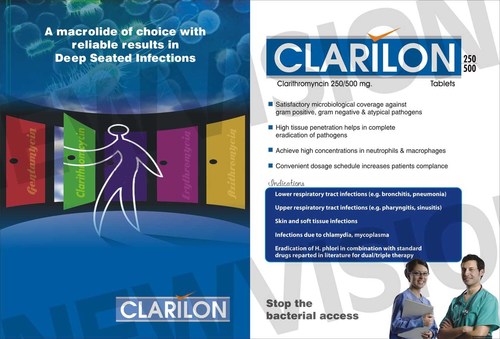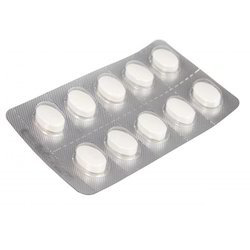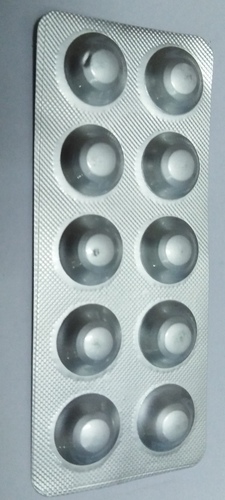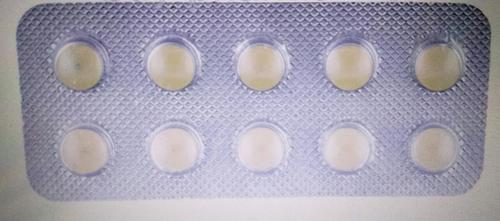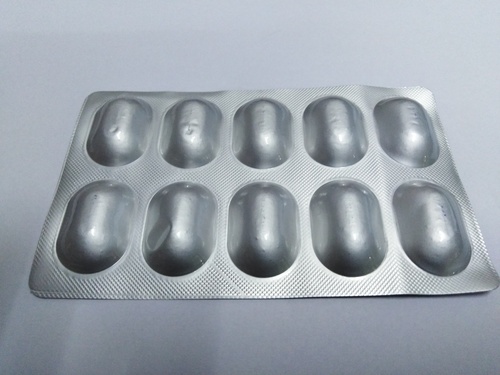
Amoxicillin 250/500 Capsules
Product Details:
- Drug Type General Medicines
- Ingredients AMOXICILLIN 250/500 CAPSULES
- Physical Form Capsules
- Function Antibiotic Medicine
- Recommended For Suitable For All
- Dosage As directed by the physician
- Quantity 500 Boxes
- Click to View more
Amoxicillin 250/500 Capsules Price And Quantity
- 1.00 - 1.00 INR
- 1 INR
- 500 Box
Amoxicillin 250/500 Capsules Product Specifications
- Capsules
- Antibiotic Medicine
- AMOXICILLIN 250/500 CAPSULES
- Below 25/C. Protect form light.
- 500 Boxes
- General Medicines
- As directed by the physician
- Suitable For All
Amoxicillin 250/500 Capsules Trade Information
- Per Day
- 45 Days
- Within a certain price range free samples are available
- 10*10
- All India
- Drug Licence, WHO GMP Certified, FSSAI, USFDA Approved
Product Description
DESCRIPTION
Formulations of MEDCLAVE contain amoxicillin, a semisynthetic antibiotic, an analog of ampicillin, with a broad spectrum of bactericidal activity against many Gram-positive and Gram-negativemicroorganisms. Chemically, it is (2S,5,R,6,R)-6-[(,R)-(-)-2-amino-2-(p-hydroxyphenyl)acetamido]-3,3-dimethyl-7-oxo-4-thia-1-azabicyclo[3.2.0]heptane-2-carboxylic acid trihydrate. It may be represented structurally as:
The amoxicillin molecular formula is C16H19N3O5S3H2O, and the molecular weight is 419.45.
Capsules: Each capsule of MEDCLAVE (amoxicillin) , with royal blue opaque cap and pink opaque body, contains 250 mg or 500 mg amoxicillin as the trihydrate. The cap and body of the 250-mg capsule are imprinted with the product name MEDCLAVE (amoxicillin) and 250; the cap and body of the 500-mg capsule are imprinted with MEDCLAVE (amoxicillin) and 500. Inactive ingredients: D&C Red No. 28, FD&C Blue No. 1, FD&C Red No. 40, gelatin, magnesium stearate, and titanium dioxide.
Tablets: Each tablet contains 500 mg or 875 mg amoxicillin as the trihydrate. Each film-coated, capsule-shaped, pink tablet is debossed with MEDCLAVE (amoxicillin) centered over 500 or 875, respectively. The 875-mg tablet is scored on the reverse side. Inactive ingredients: Colloidal silicon dioxide, crospovidone, FD&C Red No. 30 aluminum lake, hypromellose, magnesium stearate, microcrystalline cellulose, polyethylene glycol, sodium starch glycolate, and titanium dioxide.
Powder for Oral Suspension: Each 5 mL of reconstituted suspension contains 125 mg, 200 mg, 250 mg or 400 mg MEDCLAVE (amoxicillin) as the trihydrate. Each 5 mL of the 125-mg reconstituted suspension contains 0.11 mEq (2.51 mg) of sodium. Each 5 mL of the 200-mg reconstituted suspension contains 0.15 mEq (3.39 mg) of sodium. Each 5 mL of the 250-mg reconstituted suspension contains 0.15 mEq (3.36 mg) of sodium; each 5 mL of the 400-mg reconstituted suspension contains 0.19 mEq (4.33 mg) of sodium. Inactive ingredients: FD&C Red No. 3, flavorings, silica gel, sodium benzoate, sodium citrate, sucrose, and xanthan gum.
INDICATIONS
Infections Of The Ear, Nose, And Throat
MEDCLAVE (amoxicillin) is indicated in the treatment of infections due to susceptible (ONLY “negative) isolates of Streptococcus species.-hemolytic isolates only), Streptococcus pneumoniae, Staphylococcus spp., or Haemophilus influenzae.
Infections Of The Genitourinary Tract
MEDCLAVE (amoxicillin) is indicated in the treatment of infections due to susceptible (ONLY -lactamase“negative) isolates of Escherichia coli, Proteus mirabilis, or Enterococcus faecalis.
Infections Of The Skin And Skin Structure
MEDCLAVE (amoxicillin) is indicated in the treatment of infections due to susceptible (ONLY negative) isolates of Streptococcus spp. (²-hemolytic isolates only), Staphylococcus spp., or E. coli.
Infections Of The Lower Respiratory Tract
MEDCLAVE (amoxicillin) is indicated in the treatment of infections due to susceptible (ONLY “negative) isolates of Streptococcus spp. -hemolytic isolates only), S. pneumoniae, Staphylococcus spp., orH. influenzae.
Helicobacter Pylori Infection
Triple Therapy for Helicobacter Pylori with Clarithromycin and Lansoprazole
MEDCLAVE (amoxicillin) , in combination with clarithromycin plus lansoprazole as triple therapy, is indicated for the treatment of patients with H. pylori infection and duodenal ulcer disease (active or 1-year history of a duodenal ulcer) to eradicate H. pylori. Eradication of H. pylori has been shown to reduce the risk of duodenal ulcer recurrence.
Dual Therapy for H. Pylori with Lansoprazole
MEDCLAVE (amoxicillin) , in combination with lansoprazole delayed-release capsules as dual therapy, is indicated for the treatment of patients with H. pylori infection and duodenal ulcer disease (active or 1-year history of a duodenal ulcer) who are either allergic or intolerant to clarithromycin or in whom resistance to clarithromycin is known or suspected. (See the clarithromycin package insert, Microbiology.) Eradication of H. pylori has been shown to reduce the risk of duodenal ulcer recurrence.
Usage
To reduce the development of drug-resistant bacteria and maintain the effectiveness of MEDCLAVE (amoxicillin) and other antibacterial drugs, MEDCLAVE (amoxicillin) should be used only to treat infections that are proven or strongly suspected to be caused by bacteria. When culture and susceptibility information are available, they should be considered in selecting or modifying antibacterial therapy. In the absence of such data, local epidemiology and susceptibility patterns may contribute to the empiric selection of therapy.
DOSAGE AND ADMINISTRATION
Dosing For Adult And Pediatric Patients > 3 Months Of Age
Treatment should be continued for a minimum of 48 to 72 hours beyond the time that the patient becomes asymptomatic or evidence of bacterial eradication has been obtained. It is recommended that there be at least 10 days' treatment for any infection caused by Streptococcus pyogenes to prevent the occurrence of acute rheumatic fever. In some infections, therapy may be required for several weeks. It may be necessary to continue clinical and/or bacteriological follow-up for several months after cessation of therapy.
Table 1: Dosing Recommendations for Adult and Pediatric Patients > 3 Months of Age
|
Infection |
Severitya |
Usual Adult Dose |
Usual Dose for Children > 3 Monthsb |
|
Ear/Nose/Throat Skin/Skin Structure Genitourinary Tract |
Mild/Moderate |
500 mg every 12 hours or 250 mg every 8 hours |
25 mg/kg/day in divided doses every 12 hours or 20 mg/kg/day in divided doses every 8 hours |
|
Severe |
875 mg every 12 hours or 500 mg every 8 hours |
45 mg/kg/day in divided doses every 12 hours or 40 mg/kg/day in divided doses every 8 hours |
|
|
Lower Respiratory Tract |
Mild/Moderate or Severe |
875 mg every 12 hours or 500 mg every 8 hours |
45 mg/kg/day in divided doses every 12 hours or 40 mg/kg/day in divided doses every 8 hours |
A Dosing for infections caused by bacteria that are intermediate in their susceptibility to amoxicillin should follow the recommendations for severe infections.
bThe children's dosage is intended for individuals whose weight is less than 40 kg. Children weighing 40 kg or more should be dosed according to the adult recommendations.
Dosing In Neonates And Infants Aged 12 Weeks ( 3 Months)
Treatment should be continued for a minimum of 48 to 72 hours beyond the time that the patient becomes asymptomatic or evidence of bacterial eradication has been obtained. It is recommended that there be at least 10 days' treatment for any infection caused by Streptococcus pyogenes to prevent the occurrence of acute rheumatic fever. Due to incompletely developed renal function affecting elimination of amoxicillin in this age group, the recommended upper dose of MEDCLAVE is 30 mg/kg/day divided every 12 hours. There are currently no dosing recommendations for pediatric patients with impaired renal function.
Dosing For H. Pylori Infection
Triple therapy
The recommended adult oral dose is 1 gram MEDCLAVE, 500 mg clarithromycin, and 30 mg lansoprazole, all given twice daily (every 12 hours) for 14 days.
Dual therapy
The recommended adult oral dose is 1 gram MEDCLAVE and 30 mg lansoprazole, each given three times daily (every 8 hours) for 14 days. Please refer to clarithromycin and lansoprazole full prescribing information.
Dosing In Renal Impairment
- Patients with impaired renal function do not generally require a reduction in dose unless the impairment is severe.
- Severely impaired patients with a glomerular filtration rate of < 30 mL/min. should not receive a 875-mg dose.
- Patients with a glomerular filtration rate of 10 to 30 mL/min should receive 500 mg or 250 mg every 12 hours, depending on the severity of the infection.
- Patients with a glomerular filtration rate less than 10 mL/min should receive 500 mg or 250 mg every 24 hours, depending on severity of the infection.
- Hemodialysis patients should receive 500 mg or 250 mg every 24 hours, depending on severity of the infection. They should receive an additional dose both during and at the end of dialysis.
Directions For Mixing Oral Suspension
Tap bottle until all powder flows freely. Add approximately 1/3 of the total amount of water for reconstitution (see Table 2) and shake vigorously to wet powder. Add remainder of the water and again shake vigorously.
Table 2: Amount of Water for Mixing Oral Suspension
|
Strength |
Bottle Size |
Amount of Water Reauired for Reconstitution |
|
Oral Suspension 125 mg/5 mL |
80 mL |
62 mL |
|
100 mL |
78 mL |
|
|
150 mL |
116 mL |
|
|
Oral Suspension 200 mg/5 mL |
50 mL |
39 mL |
|
75 mL |
57 mL |
|
|
100 mL |
76 mL |
|
|
Oral Suspension 250 mg/5 mL |
80 mL |
59 mL |
|
100 mL |
74 mL |
|
|
150 mL |
111 mL |
|
|
Oral Suspension 400 mg/5 mL |
50 mL |
36 mL |
|
75 mL |
54 mL |
|
|
100 mL |
71 mL |
After reconstitution, the required amount of suspension should be placed directly on the child's tongue for swallowing. Alternate means of administration are to add the required amount of suspension to formula, milk, fruit juice, water, ginger ale, or cold drinks. These preparations should then be taken immediately.
NOTE: SHAKE ORAL SUSPENSION WELL BEFORE USING. Keep bottle tightly closed. Any unused portion of the reconstituted suspension must be discarded after 14 days. Refrigeration is preferable, but not required.
HOW SUPPLIED
Dosage Forms And Strengths
Capsules
250 mg, 500 mg. Each capsule of amoxicillin, with royal blue opaque cap and pink opaque body, contains 250 mg or 500 mg amoxicillin as the trihydrate. The cap and body of the 250-mg capsule are imprinted with the product name amoxicillin and 250; the cap and body of the 500 mg capsule are imprinted with amoxicillin and 500.
Tablets
500 mg, 875 mg. Each tablet contains 500 mg or 875 mg amoxicillin as the trihydrate. Each film-coated, capsule-shaped, pink tablet is debossed with amoxicillin centered over 500 or 875, respectively. The 875-mg tablet is scored on the reverse side.
Powder for Oral Suspension
125 mg/5 mL, 200 mg/5 mL, 250 mg/5 mL, 400 mg/5 mL. Each 5 mL of reconstituted strawberry-flavored suspension contains 125 mg amoxicillin as the trihydrate. Each 5 mL of reconstituted bubble-gumflavored suspension contains 200 mg, 250 mg or 400 mg amoxicillin as the trihydrate.
Other Products in 'Pharma Tablets' category
 |
MEDILON HEALTHCARE
All Rights Reserved.(Terms of Use) Developed and Managed by Infocom Network Private Limited. |

 Send Inquiry
Send Inquiry